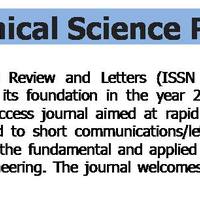
Editor CSRL
You can download all full text articles published in Chemical Science Review and Letters for free of charge in www.chesci.com.
Chemical Science Review and Letters is an international interdisciplinary journal that publishes letters/communications, full length research and review articles in all the fields of chemical science. For more information please visit www.chesci.com
Address: www.chesci.com
Chemical Science Review and Letters is an international interdisciplinary journal that publishes letters/communications, full length research and review articles in all the fields of chemical science. For more information please visit www.chesci.com
Address: www.chesci.com
less
Related Authors
Hassan Madkour
Ain Shams
Mosad Ghareeb
Theodor Bilharze Research Institute
Shahana Kazmi
Dadabhoy Institute of Higher Education
Muhammad Saeed
MNS UET
Magda Ibrahim
Al-Azhar University






Uploads
Papers by Editor CSRL
primigenius (cattle) and Ovis aries (sheep) were determined.
The moisture, ash, crude lipid, crude fibre, crude protein,
carbohydrate (proximate), sodium, potassium, calcium,
phosphorus (macro element), iron, magnesium, manganese
and zinc (micro element) content of samples from Bos
primigenius range from 8.99-10.08%, 9.01-10.99%, 7.15-
9.99%, 10.86-12.98%, 2.24-2.97%, 2.21-3.99%, 0.658-
0.885%, 0.122-0.322%, 0.648-0.883%, 0.119-0.196%, 1242-
1517 mg/kg, 2136-3925 mg/kg, 16.4-30.6 mg/kg and 17.01-
30.46 mg/kg respectively. Values for samples sourced from
Ovis aries range from 0.98-80.01%, 72.31-77.01%, 0.05-
0.07%, 0.07-0.09%, 0.79-0.99%, 0.87-0.99%, 0.639-0.860%,
0.404-0.492%, 0.758-0.901%, 0.139-0.157%, 1425-1472
mg/kg, 2468-3897 mg/kg, 46.40-55.10 mg/kg and 19.99-
50.97 mg/kg respectively. Comparison of the obtained values
showed no significance difference. Therefore authors
recommend the use of locally sourced blood meal as
supplement to the expensive imported blood meal in order to
reduce the cost of poultry production.
corrosion in a 2 M HNO3 solution in a temperature range
from 283 to 313 K was measured by using the weight loss,
potentiodynamic polarization and electrochemical impedance
spectroscopy methods. The results obtained show that the oil
inhibits the corrosion of copper in a solution of 2M HNO3
and that the effectiveness of the inhibition increases with an
increase of the concentration of the inhibitor, and decreases
proportionally with a decrease in temperature. It appears from
the potentiodynamic polarization studies, that inhibitor is
anodic. The dissolution kinetics data were studied.
for a variety of applications such as military, aerospace,
electrical industries and automotive purposes owing to their
improved properties such as high strength to weight ratio,
good ductility, high strength and high modulus, excellent
wear and corrosion resistance. There are wide variety of
processes for processing the AMMC’s, in this context only
stir casting processes is considered, as it is found to be
economical for manufacturing large components. Stir casting
is the method used for large scale production due to its
flexibility and simplicity. This paper presents the influence
of various reinforced particles and process parameters on the
properties of aluminum based metal matrix composite
through stir casting process.
a multi-national, regional, tertiary education institution in
Ethiopia where investigated using open-ended of
questionnaires of diagnostic instrument contained 17 items
followed up semi- structured interview distributed across
basic chemical thermodynamics concepts. The research
finding suggests that chemical thermodynamics is a topic
fraught with conceptual difficulties and alternative
conceptions based on the result from the study most physical
chemistry students in our sample lack rudimentary
understanding of thermodynamic concepts, there is no
recognition of the fact that change in G of the system is
directly related to change in S of the universe, there is
uncertainty as to whether a spontaneous process requires
entropy of the system or the entropy of the universe to
increase, there is in certainty as to whether G < 0 implies
that entropy of the system or entropy of the
universe will increase. Based on the result of
this diagnostic test instrument and structured
interview based on the results, an alternative
approach in which content – driven extra
tutorials, are suggested for remediation that
can partially tackle the source of learning
difficulties in chemical thermodynamics
bath deposition (M-CBD) has been used to deposit copper
thiocyanate (CuSCN) thin films. The CuSCN thin films were
deposited onto glass and FTO coated glass substrates from an
aqueous medium at room temperature. To obtain good quality
of thin films, preparative conditions such as concentration,
pH of precursor solution and adsorption, reaction and rinsing
time durations were optimized at room temperature. The
structural, morphological, optical, electrical and
photoelectronchemical (PEC) properties of the films were
investigated. X-ray diffraction (XRD) patterns of CuSCN thin
films reveals that the films have a rhombohedral structure.
The band gap was found to be 3.9 eV. The PEC studies
showed that the material is a wide band gap. PACS: 81.15.-
z; 68.55.-a; 78.20
aminobenzoic acid and it’s Mn(II),Ni(II) and Cu(II) transition
metal complexes were synthesized. Structures of the ligand
and complexes were derived on the basis of various analytical
techniques such as 1H NMR, 13C NMR, infrared, mass,
electronic spectroscopy, elemental, magnetic and
conductance studies. Structural evaluation established that a
1:1 stoichiometry exists between the metal and ligand and the
chelates possess general formula [ML(Ac)(H2O)3]. Geometry
of all the complexes was found to be octahedral. Thermal
decomposition kinetics and mechanism of the metal chelates
were studied by TG and DTA techniques. The TG curve of
all chelates showed a two stage decomposition pattern in the
TG trace which is supported by DTA data. The
decomposition of these chelates was found to follow first
order kinetics, but the first stage decomposition of Mn(II)
was 2/3 order of reaction.
primigenius (cattle) and Ovis aries (sheep) were determined.
The moisture, ash, crude lipid, crude fibre, crude protein,
carbohydrate (proximate), sodium, potassium, calcium,
phosphorus (macro element), iron, magnesium, manganese
and zinc (micro element) content of samples from Bos
primigenius range from 8.99-10.08%, 9.01-10.99%, 7.15-
9.99%, 10.86-12.98%, 2.24-2.97%, 2.21-3.99%, 0.658-
0.885%, 0.122-0.322%, 0.648-0.883%, 0.119-0.196%, 1242-
1517 mg/kg, 2136-3925 mg/kg, 16.4-30.6 mg/kg and 17.01-
30.46 mg/kg respectively. Values for samples sourced from
Ovis aries range from 0.98-80.01%, 72.31-77.01%, 0.05-
0.07%, 0.07-0.09%, 0.79-0.99%, 0.87-0.99%, 0.639-0.860%,
0.404-0.492%, 0.758-0.901%, 0.139-0.157%, 1425-1472
mg/kg, 2468-3897 mg/kg, 46.40-55.10 mg/kg and 19.99-
50.97 mg/kg respectively. Comparison of the obtained values
showed no significance difference. Therefore authors
recommend the use of locally sourced blood meal as
supplement to the expensive imported blood meal in order to
reduce the cost of poultry production.
corrosion in a 2 M HNO3 solution in a temperature range
from 283 to 313 K was measured by using the weight loss,
potentiodynamic polarization and electrochemical impedance
spectroscopy methods. The results obtained show that the oil
inhibits the corrosion of copper in a solution of 2M HNO3
and that the effectiveness of the inhibition increases with an
increase of the concentration of the inhibitor, and decreases
proportionally with a decrease in temperature. It appears from
the potentiodynamic polarization studies, that inhibitor is
anodic. The dissolution kinetics data were studied.
for a variety of applications such as military, aerospace,
electrical industries and automotive purposes owing to their
improved properties such as high strength to weight ratio,
good ductility, high strength and high modulus, excellent
wear and corrosion resistance. There are wide variety of
processes for processing the AMMC’s, in this context only
stir casting processes is considered, as it is found to be
economical for manufacturing large components. Stir casting
is the method used for large scale production due to its
flexibility and simplicity. This paper presents the influence
of various reinforced particles and process parameters on the
properties of aluminum based metal matrix composite
through stir casting process.
a multi-national, regional, tertiary education institution in
Ethiopia where investigated using open-ended of
questionnaires of diagnostic instrument contained 17 items
followed up semi- structured interview distributed across
basic chemical thermodynamics concepts. The research
finding suggests that chemical thermodynamics is a topic
fraught with conceptual difficulties and alternative
conceptions based on the result from the study most physical
chemistry students in our sample lack rudimentary
understanding of thermodynamic concepts, there is no
recognition of the fact that change in G of the system is
directly related to change in S of the universe, there is
uncertainty as to whether a spontaneous process requires
entropy of the system or the entropy of the universe to
increase, there is in certainty as to whether G < 0 implies
that entropy of the system or entropy of the
universe will increase. Based on the result of
this diagnostic test instrument and structured
interview based on the results, an alternative
approach in which content – driven extra
tutorials, are suggested for remediation that
can partially tackle the source of learning
difficulties in chemical thermodynamics
bath deposition (M-CBD) has been used to deposit copper
thiocyanate (CuSCN) thin films. The CuSCN thin films were
deposited onto glass and FTO coated glass substrates from an
aqueous medium at room temperature. To obtain good quality
of thin films, preparative conditions such as concentration,
pH of precursor solution and adsorption, reaction and rinsing
time durations were optimized at room temperature. The
structural, morphological, optical, electrical and
photoelectronchemical (PEC) properties of the films were
investigated. X-ray diffraction (XRD) patterns of CuSCN thin
films reveals that the films have a rhombohedral structure.
The band gap was found to be 3.9 eV. The PEC studies
showed that the material is a wide band gap. PACS: 81.15.-
z; 68.55.-a; 78.20
aminobenzoic acid and it’s Mn(II),Ni(II) and Cu(II) transition
metal complexes were synthesized. Structures of the ligand
and complexes were derived on the basis of various analytical
techniques such as 1H NMR, 13C NMR, infrared, mass,
electronic spectroscopy, elemental, magnetic and
conductance studies. Structural evaluation established that a
1:1 stoichiometry exists between the metal and ligand and the
chelates possess general formula [ML(Ac)(H2O)3]. Geometry
of all the complexes was found to be octahedral. Thermal
decomposition kinetics and mechanism of the metal chelates
were studied by TG and DTA techniques. The TG curve of
all chelates showed a two stage decomposition pattern in the
TG trace which is supported by DTA data. The
decomposition of these chelates was found to follow first
order kinetics, but the first stage decomposition of Mn(II)
was 2/3 order of reaction.